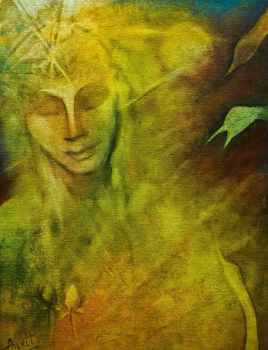
Step into the world of Indian Miniature Paintings, where colors, lines, and strokes come together to create magnificent works of art. These paintings, although small in size, are colossal in beauty and richness, capturing the essence of India's diverse and vibrant culture.
The history of Indian Miniature Paintings dates back to the 7th century when they were primarily created to illustrate religious texts. These paintings were a means of expression for Indian artists, showcasing their unique style and skills. Over the centuries, Indian miniature paintings evolved to reflect the cultural and historical changes that took place in the country.
Indian Miniature Paintings hold immense cultural and historical significance in India. They provide a glimpse into the lifestyles, traditions, and beliefs of people in different periods, showcasing the diversity and richness of India's cultural heritage. These paintings are not just works of art but also serve as historical documents that provide insight into the social and political landscape of the time they were created.
From the Mughal era to the Rajput period, Indian Miniature Paintings depict various themes and styles that reflect the artistic diversity of the country. They showcase a fusion of Persian, Indian, and European styles, creating a unique blend that is quintessentially Indian.
Join me on a journey through the rich and colorful world of Indian Miniature Paintings, where we will explore their history, cultural significance, and styles, and delve into the secrets of this magnificent art form.
Types of Indian Miniature Paintings
Indian Miniature Paintings are a testament to the country's rich artistic heritage, showcasing the diverse and vibrant culture of India. Over the centuries, different schools of painting emerged, each with its own unique style, subject matter, and color palette.
The major schools of Indian Miniature Paintings include:
-
Mughal School: This school of painting emerged during the Mughal period (16th-19th century) and was influenced by Persian and Indian styles. It is known for its naturalistic and realistic style, depicting scenes from the royal courts, hunting expeditions, and portraits of Mughal emperors and their families.
-
Rajasthani School: This school of painting emerged in the Rajput kingdoms of Rajasthan and Central India during the 17th-19th century. It is known for its bold and vibrant colors, intricate detailing, and depictions of Hindu mythology and folk tales.
-
Pahari School: This school of painting emerged in the hilly regions of Himachal Pradesh, Jammu, and Kashmir during the 17th-19th century. It is known for its delicate and lyrical style, depicting scenes from the courtly life of the hill kingdoms, as well as religious and mythological themes.
-
Deccani School: This school of painting emerged in the Deccan plateau during the 16th-19th century. It is known for its distinctive style, blending Persian and Indian styles, and depicting scenes from the royal courts, hunting expeditions, and religious and mythological themes.
Each school of painting has its own distinctive features, such as:
-
Mughal School: The Mughal School is known for its naturalistic and realistic style, which is characterized by detailed and lifelike depictions of people and animals. The color palette is subtle, with a focus on earthy tones such as brown, green, and blue.
-
Rajasthani School: The Rajasthani School is known for its bold and vibrant colors, intricate detailing, and use of gold and silver leaf. The subject matter often includes depictions of Hindu deities, folk tales, and courtly life.
-
Pahari School: The Pahari School is known for its delicate and lyrical style, with a focus on nature and love themes. The color palette is soft and pastel, with a focus on shades of green, blue, and pink.
-
Deccani School: The Deccani School is known for its distinctive style, which blends Persian and Indian styles. The color palette is rich and vibrant, with a focus on bright hues such as red, green, and gold. The subject matter often includes depictions of royal courts, hunting expeditions, and religious and mythological themes.
In conclusion, the different schools of Indian Miniature Paintings reflect the diverse cultural and historical landscape of India, each with its own unique style, subject matter, and color palette. These paintings continue to inspire and captivate audiences, showcasing the beauty and richness of India's artistic heritage.
Techniques Used in Indian Miniature Paintings
Indian Miniature Paintings are not just works of art but also a testament to the exceptional skills and techniques used by Indian artists. These paintings are created using traditional methods that have been passed down from generation to generation.
The traditional techniques used in Indian Miniature Paintings include:
-
Natural pigments: Indian artists use natural pigments made from minerals, plants, and insects to create their colors. These pigments are mixed with a binding agent such as gum arabic to make them stick to the surface of the painting.
-
Gold and silver leaf: Gold and silver leaf are used to add a touch of luxury and opulence to Indian Miniature Paintings. The leaf is applied to the surface using a special adhesive and is then burnished to create a shiny and reflective surface.
-
Miniature brushes: Indian Miniature Paintings are created using miniature brushes made of squirrel hair. These brushes are incredibly thin and delicate, allowing the artist to create intricate details and patterns.
The process of making Indian Miniature Paintings includes:
-
Preparing the surface: The surface of the painting is prepared by coating it with a layer of natural glue made from animal hide. This helps the pigments stick to the surface and prevents them from smudging.
-
Sketching the outline: The artist then sketches the outline of the painting using a fine brush and ink. This is done to ensure that the proportions and composition of the painting are correct.
-
Layering the pigments: The pigments are then applied to the surface of the painting using a miniature brush. The artist begins by applying a base layer of color and then adds more layers to create depth and shading. Gold and silver leaf are added at this stage as well.
-
Adding details: Once the basic layers of the painting have been applied, the artist adds details such as facial features, clothing, and patterns. This is done using a fine brush and requires a steady hand and a lot of patience.
In conclusion, Indian Miniature Paintings are created using traditional techniques that have been refined and perfected over centuries. The use of natural pigments, gold and silver leaf, and miniature brushes made of squirrel hair all contribute to the unique beauty and richness of these paintings. The process of creating a miniature painting requires skill, patience, and attention to detail, resulting in magnificent works of art that continue to captivate audiences around the world.
Themes and Subject Matter of Indian Miniature Paintings
Indian Miniature Paintings are known for their rich and diverse themes and subject matter. These paintings often depict religious and mythological stories, courtly scenes, landscapes, and portraits, among other subjects.
The common themes and subjects in Indian Miniature Paintings include:
-
Religious and mythological stories: Indian Miniature Paintings often depict stories from Hindu mythology, such as the Ramayana and the Mahabharata. These paintings also frequently depict scenes from the lives of various gods and goddesses.
-
Courtly scenes: Many Indian Miniature Paintings depict scenes from the royal courts of India, showcasing the opulence and grandeur of the Mughal and Rajput kingdoms.
-
Landscapes: Some Indian Miniature Paintings feature landscapes that depict the beauty of the Indian countryside, including hills, rivers, and forests.
-
Portraits: Indian Miniature Paintings also feature portraits of kings, queens, and other notable figures, showcasing their beauty, elegance, and power.
Some famous examples of Indian Miniature Paintings include:
-
"Hamzanama": This series of paintings was commissioned by the Mughal emperor Akbar in the 16th century and depicts the adventures of the legendary hero Hamza.
-
"Ragamala": This series of paintings originated in Rajasthan in the 16th century and depicts various musical modes or "ragas". The paintings are known for their vibrant colors and intricate details.
-
"Krishna Lila": This series of paintings depicts the life and adventures of Lord Krishna, a popular deity in Hindu mythology. The paintings are known for their intricate details and bright colors.
-
"Bani Thani": This painting depicts a woman from the Kishangarh kingdom in Rajasthan and is known for its elegant and stylized depiction of female beauty.
In conclusion, Indian Miniature Paintings feature a wide range of themes and subjects that reflect the rich cultural and historical heritage of India. From religious and mythological stories to courtly scenes, landscapes, and portraits, these paintings offer a glimpse into the world of ancient India and continue to captivate audiences around the world with their beauty and intricacy.
Significance and Legacy of Indian Miniature Paintings
Indian miniature paintings have played a significant role in documenting the cultural and historical heritage of India. These paintings are known for their intricate details, vibrant colors, and unique style, which have influenced other art forms and continue to captivate audiences around the world.
The cultural and historical significance of Indian miniature paintings includes:
-
Documenting Indian history and traditions: Indian miniature paintings often depict historical events and traditional practices, providing valuable insights into the lives and culture of ancient India. These paintings have also been used to illustrate religious texts and manuscripts, preserving them for future generations.
-
Showcasing the artistic talent of Indian artisans: Indian miniature paintings were often created by skilled artisans who worked for royal courts and wealthy patrons. These artists used traditional art techniques and materials to create works of art that continue to inspire and amaze audiences to this day.
The influence of Indian miniature paintings on other art forms includes:
-
Indian cinema: Indian miniature paintings have had a significant influence on Indian cinema, particularly in the use of vibrant colors and intricate details. Many Indian films feature elaborate sets and costumes inspired by the art of miniature painting.
-
Contemporary art: Indian miniature paintings have also influenced contemporary artists in India and around the world, who have adapted and reinterpreted traditional techniques and styles to create new works of art.
In conclusion, Indian miniature paintings have a rich cultural and historical significance, documenting the traditions and artistic talent of ancient India. Their influence can be seen in other art forms, such as Indian cinema and contemporary art, showcasing the enduring legacy of this remarkable art form.
Conclusion
Indian miniature paintings are a unique and intricate art form that originated in India centuries ago. These paintings feature a diverse range of themes and subjects, including religious and mythological stories, courtly scenes, landscapes, and portraits. They were created using traditional techniques, such as natural pigments and miniature brushes made of squirrel hair. Indian miniature paintings have played a significant role in documenting the cultural and historical heritage of India, showcasing the artistic talent of Indian artisans and influencing other art forms, such as Indian cinema and contemporary art.
It is important to appreciate the beauty and significance of Indian miniature paintings, as they offer a window into the rich cultural and historical heritage of India. By exploring these paintings, readers can gain a deeper appreciation for the art and culture of ancient India. We encourage readers to learn more about Indian miniature paintings, to visit museums and galleries to see these works of art firsthand, and to appreciate the intricate details and vibrant colors that make these paintings so remarkable.





















